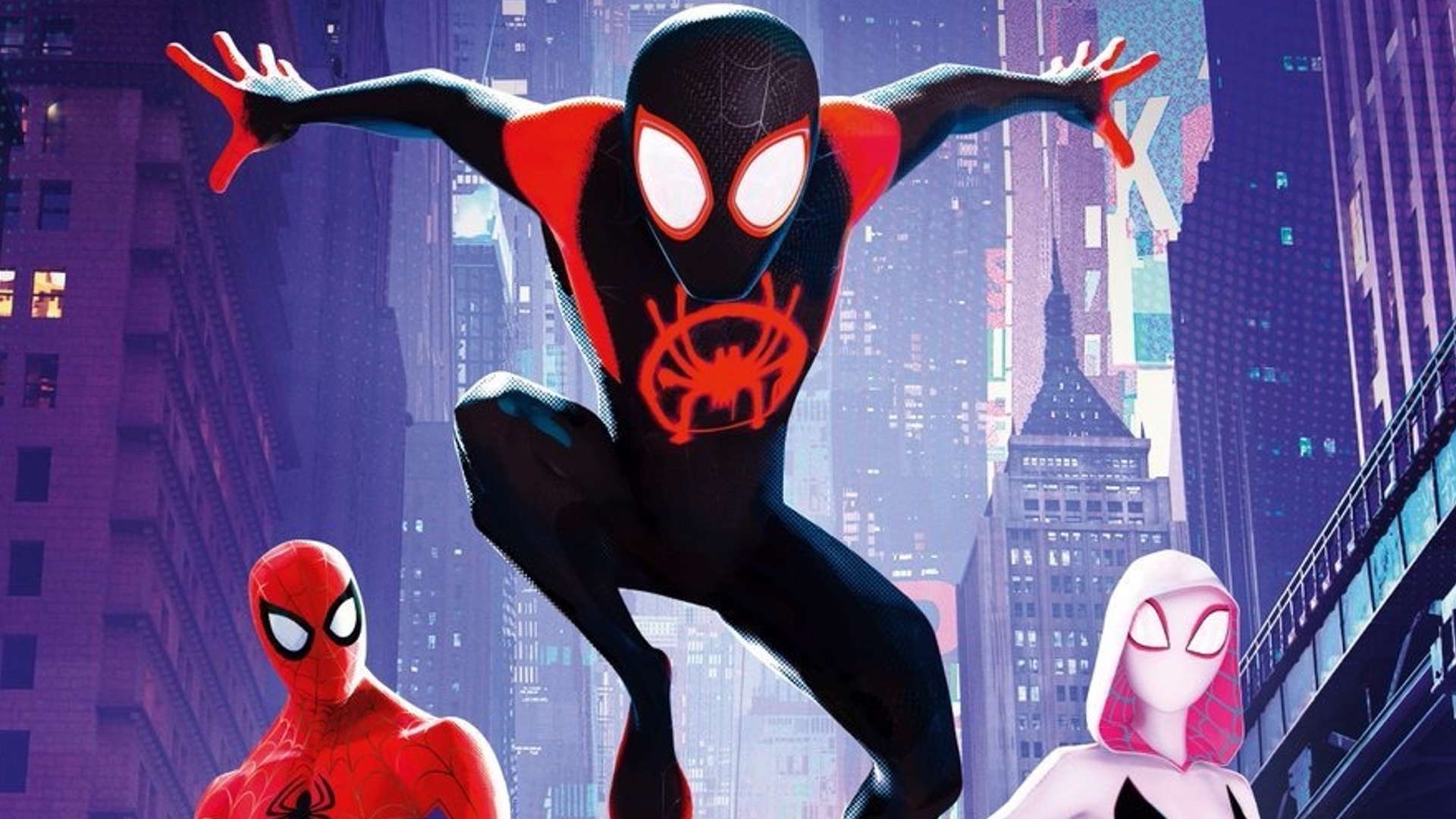Chances are, moviegoers know the drill with Peter Parker and his super-powered alter-ego by now. Spider-Man is arguably one of the most iconic superheroes in the world, particularly in cinema, and Sony Pictures has been spearheading a longstanding movie catalogue centering on the Web-Slinger since 2002, even maintaining final approval rights for the character’s recent introduction into the shared Marvel Cinematic Universe. What many everyday moviegoers no doubt don’t know however is that Peter Parker is definitely not the only Spider-Man to ever exist in the Marvel Universe. That’s because, in the printed panels, there’s an entire multiverse’s worth of Spider-folks, all seemingly stranger and more offbeat than the last!
This collection of Spider-Men and Spider-Women, all inhabiting different dimensions and universes for the most part, are collectively known in Marvel Comics canon as the ‘Spider-Verse’, and while they all have lengthy careers in their home dimensions, they often hop universes to team up against larger-than-life threats that require more than one Spider-Person to take down. Peter Parker’s original Spider-Man may now be shared with the capable hands of Marvel Studios and the MCU, but Sony Pictures still exclusively holds the rights to the alternate Spider-Verse comic book personalities, giving Sony a means to continue pursuing their own self-contained Spider-Man movie projects, while the most well-known and beloved Spidey is free to play with the Avengers and other fan-favourite live-action Marvel personalities in the MCU.
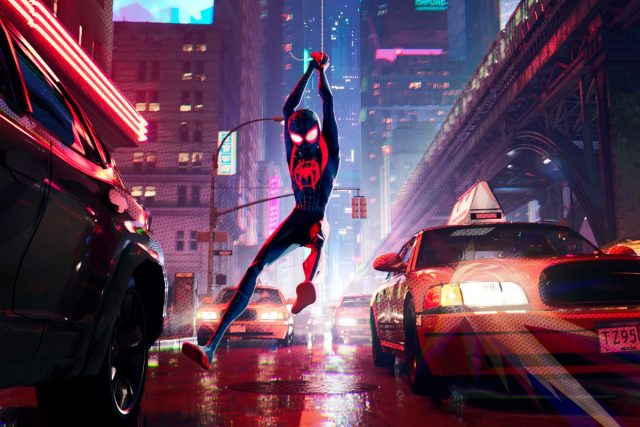
This plan is actually kind of ingenious, with Spider-Man: Into the Spider-Verse pulling out all the stops to deliver the kind of Spider-Man movie that would never fit with the current vision of Marvel Studios, while also tapping into the many Spider-Man franchise characters that Sony Pictures still exclusively holds the film rights to, essentially creating the best of both worlds (literally) for fans! It’s truly mind-blowing just how much Sony Pictures succeeds with Spider-Man: Into the Spider-Verse as well, which not only deftly dethrones Spider-Man: Homecoming as the freshest and most exciting Spider-Man movie to come to us since Sam Raimi’s original Spider-Man offerings, but also provides one of the most unique, fun and memorable superhero movie projects to currently be realized with a Marvel property that’s actually not being handled by Marvel Studios! As much as Spider-Man has already delivered several high-quality appearances in the MCU over the past three years, Spider-Man: Into the Spider-Verse may honestly be the best Spider-Man movie to date, period, and one that certainly makes a compelling case for realizing more beloved superheroes in big screen animation!
There are several alternate Spider-People in Spider-Man: Into the Spider-Verse, but the central personality in the movie is Miles Morales, the so-called ‘Ultimate Spider-Man’ of the Marvel Comics Multiverse. In Marvel Comics lore, the Peter Parker of the parallel Ultimate Universe ends up being killed in a battle with the Green Goblin, resulting in another young teen, Miles Morales, sustaining his own genetically-altered spider bite, and gaining his own Spider-Man-like abilities, with a couple of additions such as camouflage, a stinging touch, and the ability to fire venomous blasts. In Spider-Man: Into the Spider-Verse, a version of Peter Parker has already been Spider-Man for at least a decade in Miles’ universe, but after tragedy strikes, and Miles inadvertently ends up getting his own genetically-altered spider bite, a la the comics, he ends up becoming the representative Spider-Man for his home universe, after a parallel universe’s Peter Parker shows up in Miles’ version of New York, which ties into the main danger threatening Miles’ home dimension.
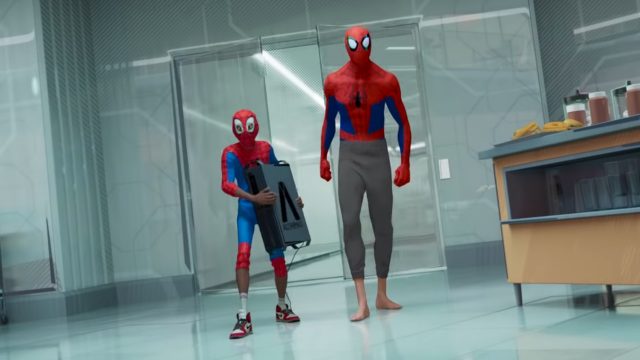
It sounds complicated, and might baffle less initiated moviegoers in its opening minutes, but Spider-Man: Into the Spider-Verse very skillfully outlines its crucial characters over the course of its progression, and how their alternate dimensions work. Shameik Moore effectively carries most of the movie’s grounded humanity in the lead role of Miles as well, a character who is as much the eyes of the audience as he is a struggling teenager, one who has suddenly found himself scrambling to live up to a man who has already done years of amazing things with the Spider-Man mantle. The alternate Peter Parker, by contrast, the one that supposedly comes from the mainline Marvel Universe on Earth-616 (protip: Every comic book/superhero universe in Marvel lore and DC lore alike has a numbered designation, something that also holds true in this movie), is a complacent, cynical and lazy thirty-seven-year-old bum, voiced fittingly by Jake Johnson, who becomes fat, inept and loses faith in his heroic cause after being divorced by his wife, Mary-Jane Watson, voiced in both universes by Zoe Kravitz.
Moore and Johnson provide both an entertaining double act, and an effective dramatic clash between youth and experience. Johnson’s broken Peter Parker initially seems to merely stand as a simple comic foil to the well-meaning Miles, but Spider-Man: Into the Spider-Verse rather brilliantly adds inspired shades of humanity to the character at perfect intervals over the course of the movie’s progression, finding that last shred of heroism that can help grow with Miles’ badgering demands to be taught in the ways of being a Spider-Man successor. Helping in this mission is the other most influential alternate Spider-Person in the movie, Spider-Gwen (who is known as Spider-Woman in her home universe, in this movie’s case), a.k.a. former Spider-Man love interest, Gwen Stacy, voiced here by Hailee Steinfeld. Gwen’s Peter Parker was killed shortly after Gwen herself sustained the genetically-altered spider bite in her home universe, and like Johnson’s Peter Parker, Gwen ends up in Miles’ universe after a mishap with a dimension-ripping ray built by the Alchemax corporation, the same corporation that created the mutant spider that gave Miles his powers.
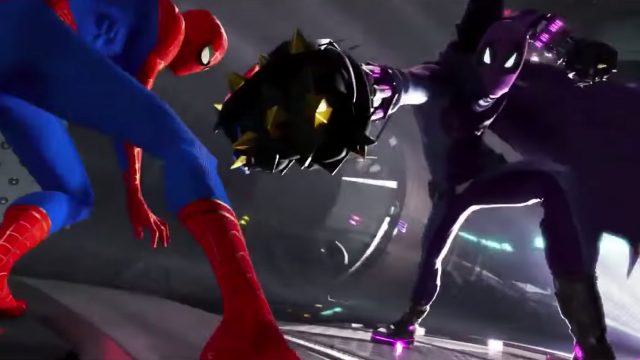
The other Spider-People are essentially upheld on their gimmicks, between the comically morose Spider-Man Noir, voiced by Nicolas Cage, the anime-esque Peni Parker and her spider mech, SP//dr, voiced by Kimiko Glenn, and anthropomorphic pig superhero, Spider-Ham, voiced by John Mulaney. This approach feels appropriate though, preventing the story arcs from becoming too busy and overstuffed, while Miles’ core journey as a fledgling superhero can still shine through. A similar approach is also taken with most of the villains, since there’s quite the roster of baddies on display here, including Green Goblin, Prowler and Scorpion, as revealed by the trailers. The lead villain however is Wilson Fisk, a.k.a. the Kingpin, a villain that seems to have been allowed for Spider-Man: Into the Spider-Verse as part of Marvel’s and Sony’s Spider-Man movie sharing agreement, since he normally falls under the Daredevil movie rights that now sit with Marvel themselves. Regardless, Liev Schreiber voices Kingpin in Spider-Man: Into the Spider-Verse, an imposing, but surprisingly sympathetic antagonist with unique motivations for trying to exploit Alchemax’s dimension-altering ray, which becomes the cause of the alternate Spider-People all being sucked into Miles’ dimension, and needing to urgently get home.
Ultimately though, despite all of the fun and spectacle that you would expect in a Spider-Man movie that’s this incredibly ambitious (and it’s certainly here in spades!), the heart of the story remains with Miles and his family, as it should. Miles’ journey parallels that of Peter Parker to some extent, but in several respects, it’s altered, or even outright inverted, such as Miles having to attend a fancy private school and please his uptight police officer father, which stands in stark contrast to Peter being raised by his cash-strapped aunt. The way that Miles learns the core Spider-Man tenements of great power and great responsibility is done with humour, heart and more than a few false starts, but the huge cult appeal of Miles Morales in Marvel Comics lore is wonderfully translated to Spider-Man: Into the Spider-Verse, where he combines the stubborn do-gooder attitude of the MCU’s Peter Parker with the added emotional depth and angst that has often defined the Peter Parker portrayals from Sony’s former standalone Spider-Man movies.
Spider-Man: Into the Spider-Verse presents itself as both a family drama and an off-the-wall sci-fi adventure, and it succeeds on both counts. Like I said, the family dynamic with Miles Morales is significantly different to that of Peter Parker, and this is a key anchor throughout much of the movie’s storytelling, as is Miles coming into his own as Spider-Man through succeeding someone else, rather than pioneering the identity for the first time. Like many gifted teens, Miles is having a hard time fitting in at school, and with the demands of his police officer father, especially with so many lofty expectations placed upon him, which is true of both his civilian and superhero identities. As much as you’re getting plenty of expected Spider-Man-themed fun, the actual heart of the movie lies with Miles learning to embrace his gifts and overcome his insecurities, both as a teenager and a superhero. It’s remarkably true to the spirit of the Spider-Man character, in any form, while also providing a new take on the struggle of being Spider-Man that finally moves away from the well-worn foundation of Peter Parker.
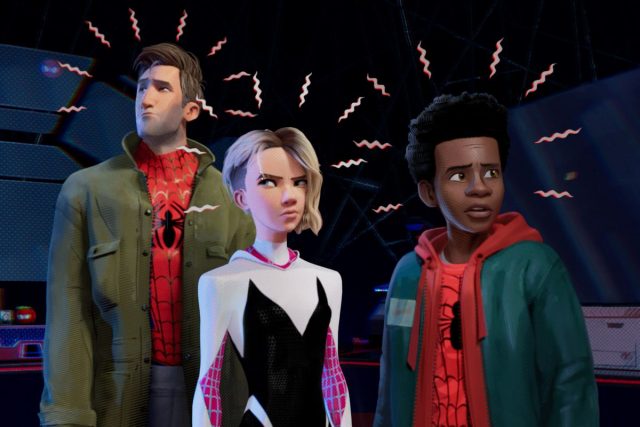
This is a movie that is definitely best experienced by knowing as little as possible about its progression as well, since there are a ton of great narrative surprises for both dedicated Spider-Man fans and general moviegoers alike. There’s a ton of love and reverence for every decade of Spider-Man franchise history throughout Spider-Man: Into the Spider-Verse, not just in film, but also in comics, television and video games too! If you’ve ever had any appreciation for Spider-Man, there’s something for you in the fun, smart and emotionally gratifying storyline behind Spider-Man: Into the Spider-Verse, even as the movie keeps constantly hitting you with new and eccentric Spider-People that you’ve never seen on film before.
(NOTE: The spoiler section, when clicked, discusses surprise character additions in Spider-Man: Into the Spider-Verse, and whether the movie is setting up any shared universe foundation for the future.)
It’s also unsurprising that there would end up being at least one major surprise villain in Spider-Man: Into the Spider-Verse, and yes, as rumour suggested, Doc Ock is indeed in the movie… As a woman! Kathryn Hahn ends up voicing a new female take on one of Spider-Man’s arch-enemies, one named ‘Olivia Octavius’ instead of ‘Otto Octavius’, who is initially disguised as an ordinary tech geek for Alchemax, simply named Olivia. It’s not until the parallel Peter Parker asks Olivia her name that she reveals herself to already have the Doc Ock tentacle harness, and that her full name is Olivia Octavius, but her friends call her, “Liv”, in one of the movie’s best jokes. The female Doc Ock then becomes one of the main enforcers for Kingpin throughout the rest of the movie, one that apparently has plenty of history with Miles’ universe’s Peter Parker, as alluded to by Aunt May during one of the later action scenes. Given that an all-female spin-off to Spider-Man: Into the Spider-Verse is in development, it seems probable that the gender swap for Doc Ock is likely being done to set her up as a potential villain for that spin-off movie.
Spider-Man: Into the Spider-Verse has a whopping three directors overseeing it, and considering the hyper-kinetic action and photoshop-flavoured comic book-esque animation, it’s no wonder why! This is an extremely technically ambitious movie, perhaps the most technically ambitious movie that Sony Pictures Animation has ever attempted, but fortunately, its direction is sublime throughout the production. The animation is primarily overseen by former Dreamworks Animation veterans, Bob Perschietti and Peter Ramsey, while Rodney Rothman, a regular Sony Pictures writer who also assisted with the script on 22 Jump Street, oversees the narrative direction. It’s just on the verge of threatening too many cooks in the kitchen, but Spider-Man: Into the Spider-Verse comes together like a well-oiled machine, balancing outstanding new animation milestones with a very heartfelt and human story that makes it all feel like it truly matters.
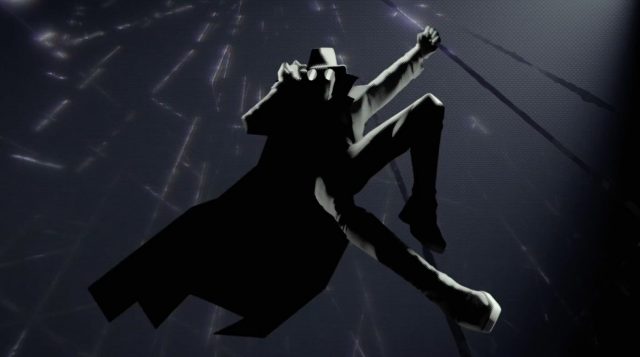
Rothman’s incredible sense of heart and wit already helped to elevate the humour of 22 Jump Street several years ago, and it does even more for Spider-Man: Into the Spider-Verse, a movie that manages to have cartoon action with real impact, and cartoon humour with real intelligence. Perschetti and Ramsey also brilliantly help the movie leap to life by combining comic book and cartoon sensibilities with Rothman’s whip-smart script, which he penned alongside part of the LEGO Movie and 21/22 Jump Street duo, Phil Lord. Even the directing style feels like an intricate mix of several highly disparate samples of Spider-Man sensibilities, which, like the Spider-Verse itself, brings so many portions together that shouldn’t work in harmony, yet somehow become even greater when they’re allowed to play off of their incredible differences to one another. There have been plenty of cleverly directed superhero movies in live-action, but Spider-Man: Into the Spider-Verse still feels like one of the best superhero directing efforts of recent memory in its animated form, showcasing how the superhero movie medium doesn’t necessarily need a live-action setting to feel clever, cool and spectacular!
Spider-Man: Into the Spider-Verse builds a soundtrack full of youthful, yet inspiring jams, almost like a mixtape. Again, that feels very appropriate, since this movie in general is a mix of many different Spider-Man stylings all rolled into one package. Daniel Pemberton composes the score for Spider-Man: Into the Spider-Verse, a more up-and-coming film composer whose credits include work on some recent well-known dramas like Molly’s Game and All the Money in the World, and, even more recently, Warner Bros. heist blockbuster, Ocean’s 8. Spider-Man: Into the Spider-Verse is a pretty big departure for Pemberton, whose previous genre credit was 2017’s infamous box office bomb, King Arthur: Legend of the Sword, though fortunately, Pemberton does appear to rise to the task. Spider-Man: Into the Spider-Verse has a very cool, eclectic soundtrack, combining several styles such as synth, jazz, R&B and cartoon orchestra, which services the movie’s youthful charm as much as it does its potent sense of larger-than-life heroics.
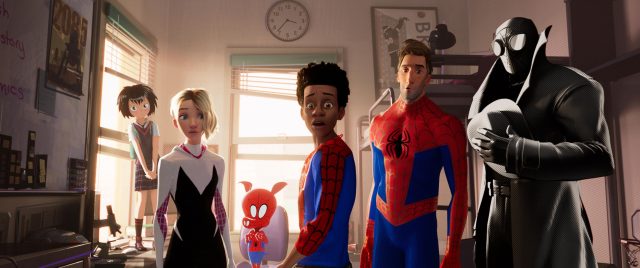
The rest of the audio work is definitely punchier than most animated movies, which likely won’t surprise moviegoers, since this is an animated movie centered around an established, highly beloved superhero. Spider-Man: Into the Spider-Verse can be very stimulating from an audio standpoint as much as a visual one, with its explosive sound mixing and hard-hitting action scenes proudly keeping pace with most any live-action superhero movie worth its salt, even if this means that less concessions are made for the more sensitive hearing of young kids. The audio work is consistently action-packed and engaging however, presenting a high-powered Saturday morning cartoon style that’s being put together on genuine Hollywood production value. Yes, that’s exactly as amazing as it sounds! You’re especially in for a treat if you have the privilege of partaking in Spider-Man: Into the Spider-Verse in a premium format such as IMAX to boot, where it becomes even more grand and powerful in scale, providing one of the best audio jobs ever realized in a Spider-Man movie, even with this being an animated one!
Spider-Man: Into the Spider-Verse could have very easily settled for being a conventionally animated CG Spider-Man movie, and that probably would have suited many fans of the Wall-Crawler just fine. Sony Pictures Animation have definitely gone the extra mile throughout the production though, pioneering a first-of-its-kind photoshop-based animation filter over the conventional CG designs, which allow Spider-Man: Into the Spider-Verse to function as if it were a living, breathing comic book that’s unfolding before your eyes! This is some of the most uniquely stunning animation that any studio has made to date, particularly Sony Pictures Animation, who have usually somewhat lagged behind the competition in terms of their animation quality, but that doesn’t appear to be an issue anymore. This is the kind of outstanding technical style that other studios are bound to try and imitate in the future, especially if Sony Pictures Animation ends up inspiring more animated superhero movies to try and follow in the footsteps of this one!

You could probably imagine that Spider-Man: Into the Spider-Verse is definitely the kind of movie that you’d want to pair with a slick 3D presentation as well, and fortunately, the movie is offered in both standard digital 3D and IMAX 3D cuts! The ambitious comic book-style photoshop perspectives don’t always play nice with the 3D presentation, mind you, with some backgrounds appearing very blurred during fast-moving scenes, as if your 3D glasses are broken. When the 3D does work however, it works beautifully, especially in the action scenes, which grip the audience with all sorts of eye-popping imagery that just wouldn’t be possible in most any live-action superhero movie! Even with some of the uneven 3D quality in a few scenes, I highly recommend springing for a pair of 3D glasses with Spider-Man: Into the Spider-Verse. The 3D hits more often than it misses, and when it works, it’s some of the most dazzling 3D to come out of any movie released in 2018, as well as some of the most spectacular 3D to come out of Sony Pictures Animation to date!
Even considering the many high points of fan-favourite Spider-Man movies like 2004’s Spider-Man 2 and 2017’s Spider-Man: Homecoming, Spider-Man: Into the Spider-Verse feels like it’s in a class all its own, and that goes well beyond the fact that it happens to be animated! It’s legitimately hard to believe that a Spider-Man movie this spectacularly brilliant came from present-day Sony Pictures alone, who very recently kickstarted a significantly more sloppy and initially unimpressive live-action Marvel Universe with the entertaining, but very flawed Venom just a couple of months beforehand. Venom only seemed to beg the question as to why Sony Pictures was still bothering to pursue standalone Marvel movie projects with the Spider-Man movie rights, despite now sharing them with the vastly superior Marvel Studios, but Spider-Man: Into the Spider-Verse successfully makes a case for why Sony shouldn’t just completely sell the Spider-Man film rights back to Marvel. Apparently, Sony truly does have some great ideas for a Spider-Man film franchise that have yet to be explored, and Spider-Man: Into the Spider-Verse is proof!
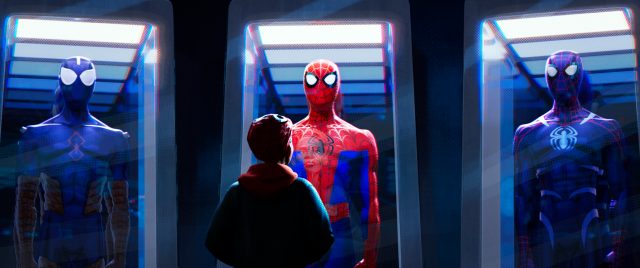
It’s practically impossible to come up with any serious complaints about Spider-Man: Into the Spider-Verse, which is the first third-party Marvel movie since 2016’s Deadpool to feel like it can legitimately compete with the Marvel Studios catalogue in terms of quality! Beyond a bit of a learning curve with the alternate dimension hook during this movie’s exposition-heavy opening, moviegoers will find themselves easily able to settle in and enjoy this ambitious and highly successful elevation of the Spider-Man movie brand, let alone established Spider-Man franchise fans, who will no doubt especially adore Spider-Man: Into the Spider-Verse as an intelligent, hilarious and action-packed love letter to every corner of this long-running superhero franchise, no matter how strange! Forget the failings of Venom. This movie offers an introduction to a Sony-run Marvel Universe that’s incredibly easy to get behind, and I can’t wait to see where the newly-minted big screen ‘Spider-Verse’ takes us next!

